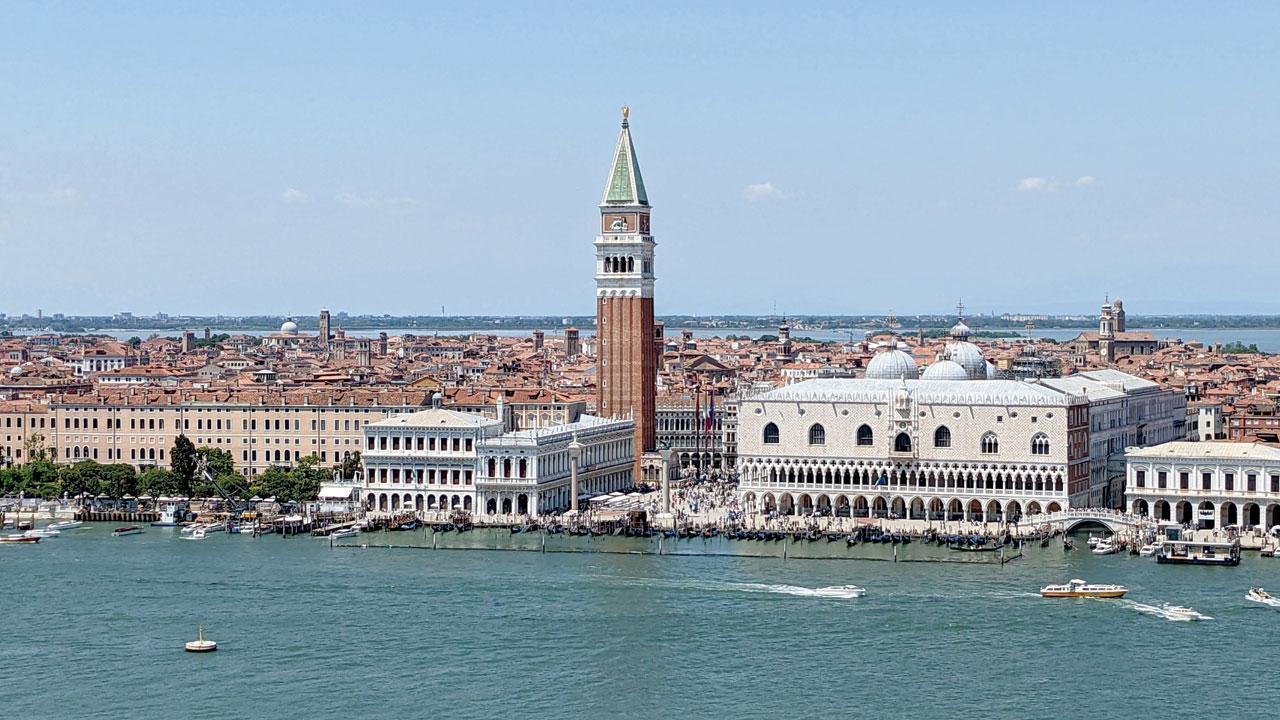After a day spent sightseeing in Venice this week when we visited the island of San Lazaro, I wondered if there is a series of alignments that brings us to where, and with whom, we are meant to be

The view from the top of the San Giorgio Maggiore bell tower. Pic/Rosalyn D’mello
Yesterday, on a whim, and in order to do vasuli of our day-long ferry tickets, my partner and I decided to take the Vaporetto from San Marco to San Lazaro, an island in the Venetian lagoon. We had read about a monastery there and, although we hadn’t booked our place in the guided tour, thought we’d wing it. We had time to kill. Plus, it was an Italian national holiday, which meant the city of Venice would possibly be overrun by day tourists. It was a good call.
ADVERTISEMENT
We were among four people on the ferry. It was around 2.45 pm. We were still reeling from the unexpectedly spectacular view from the bell tower of San Giorgio Maggiore. I couldn’t believe I hadn’t been urged by anyone to have made this visit before. I had been eyeing this island ever since I set foot in Venice in 2018, but I hadn’t felt persuaded to explore it, especially given how much sightseeing there always is to do. Then again, I wonder if there is such a thing as mystical timing when one thinks about the series of alignments that lead you to a place, and sometimes even steers the logic of who you happen to be with when you finally encounter something, and you feel sure you were meant to be exactly there, at exactly that time.
For instance, back in October 2018, when I took a Flix bus from Vienna to Bozen in order to spend time with my now-husband, to explore the possibility of us being together after having immersed ourselves in each other long-distance, after having lodged ourselves in each other’s loving gaze, I happened to made small talk with an English-speaking old Italian man. I don’t remember much of our conversation but when I asked where he was going, he said he was returning to his home in Vicenza. I asked where it was, he told me it was close to Padua and Venice, and said it was famous for its villas designed by Palladio, an architect I’d never heard of until then.
During that time in October 2018, my partner was working the harvest but had got one sunny day off, and he asked if I knew what I wanted to do. I asked him if we could go to Vicenza. He agreed and was excited by the prospect. Unfortunately, it turned out that most of the villas were closed for visits on Sundays. Still, we walked from the station to the Villa Rotunda, up on a hill, and surveyed Palladio’s exteriors, marvelling at how obsessed he clearly had been with geometry. We spent a lot of time circumambulating the stony floors, observing the landscape and imagining the interiors.
At San Giorgio Maggiore, I finally was able to glimpse what a structure designed by Palladio looked like from within. One saw the obsession with geometry come full circle. The statue of God the Father in the centre of the altar had a triangular halo instead of a circular one, a detail that amused me. I saw an element of a looped geometrical motif at several places within the church that I saw only marginally echoed on the facade of Il Redentore, another church Palladio designed on the neighbouring island of Giudecca, which we felt compelled to visit only because we happened to pass it because we needed to find an ATM, because, at the time we were, before, at San Giorgio, we couldn’t go up to the bell tower because the entrance fee could only be paid in cash. In other words, everything about our itinerary felt divinely ordained.
Still reeling from the dizzying spectacle — the panoramic view of the Venetian lagoon from the bell tower, we entered the sweet-smelling island of San Lazaro, once a leper colony until it began to be inhabited by an order of Armenian Mekhitarist monks who were fleeing Constantinople and were given this site of refuge by a papal request in 1717. We were lucky to be accommodated within a group tour and were privileged to see how the monastery had become an accidental museum, with so many objects within its collection gifted by visiting scholars, including Lord Byron, who helped build an Armenian-English vocabulary.
It was amazing and even humbling to think about how a people who survived a genocide invested their energies in building worlds, praying, wrestling with the deepest intricacies of the written word — in terms of writing, translating, and printing. What remains today at San Lazaro is a legacy, an ode to what the mind that seeks peace can accomplish.
As I gazed at the titles of leather-bound editions, like The Book of the Dead, I wondered, again, about the nobility of this endeavour contrasted against the civilizational loss of female subjectivity. All the oldest libraries are sanctuaries of male thought and erudition. Where and how do we unravel what women felt and thought and dreamed in a manner that is catalogued and accessible. On what island might such a wondrous domestic site exist?
Deliberating on the life and times of Everywoman, Rosalyn D’Mello is a reputable art critic and the author of A Handbook For My Lover. She tweets @RosaParx
Send your feedback to mailbag@mid-day.com
The views expressed in this column are the individual’s and don’t represent those of the paper.
 Subscribe today by clicking the link and stay updated with the latest news!" Click here!
Subscribe today by clicking the link and stay updated with the latest news!" Click here!






